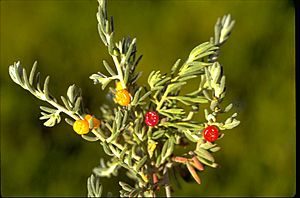Barrier saltbush facts for kids
Quick facts for kids Barrier saltbush |
|
|---|---|
 |
|
| Scientific classification | |
| Genus: |
Enchylaena
|
| Species: |
tomentosa
|
| Varieties | |
|
E. tomentosa var. tomentosa |
|
 |
|
| Distribution of ruby saltbush | |
Enchylaena tomentosa, often called barrier saltbush or ruby saltbush, is a small shrub that grows naturally in Australia.
Contents
What is Ruby Saltbush?
The ruby saltbush is a small shrub that can grow up to one meter wide. Its leaves are thin and shaped like cylinders, about 6-15mm long. Both the leaves and stems are covered in soft, woolly hairs. The plant produces juicy berries that change from green or yellow to bright red or orange as they ripen.
The name Enchylaena tomentosa helps us understand the plant. Enchylaena comes from Greek words meaning "fleshy" or "succulent" and "cloak." This refers to the ripe fruit, which looks like it's wearing a fleshy cloak. Tomentosa is a Latin word meaning "covered with dense, soft hair," which describes the plant's woolly leaves and stems.
This plant can handle very dry conditions. Because of this, it has been important to Indigenous Australians, early settlers, and even livestock. It is quite nutritious, with about 14% digestible protein and 6% digestible salt, making it a good food source for grazing animals.
How it is Classified
The ruby saltbush was first described by Robert Brown in 1810. At that time, it was the only known species in its group, Enchylaena. Over time, other similar plants were found and given different names, but they were later found to be the same as Enchylaena tomentosa. These older names are now called "taxonomic synonyms."
There are two main types, or varieties, of ruby saltbush. One is the original E. tomentosa var. tomentosa, which is quite woolly. The other is E. tomentosa var. glabra, which has fewer hairs. This less woolly type was described by George Bentham in 1870. The plant used to be in the Chenopodiaceae family, but it is now part of the Amaranthaceae family.
Where it Grows and Lives
The ruby saltbush grows all over Australia. It has also started growing naturally in New Caledonia. It can grow in many different types of soil, but it especially likes soils that are a little salty. You can find it in most dry parts of Australia, on sand plains, hillsides, near creeks, on sand dunes, and even by salt lakes. It often prefers slightly shaded spots under trees like Alectryon oleifolius and Acacia papyrocarpa.
As the distribution map shows, E. tomentosa is found across a wide area of Australia. This is likely because it can survive droughts and live in many different soil and climate zones. Another reason for its wide spread is how its seeds travel. The seeds of E. tomentosa are spread by animals that eat the fruit. This is called endozoochory. When animals digest the fruit, it can help the seeds sprout by removing the fleshy outer layer. This layer might stop the seeds from growing in bad conditions.
A study of emu droppings found that ruby saltbush seeds made up 8.5% of nearly 20,000 seeds. This was the second-highest number after nitre bush seeds. Emus are known to travel over 600 kilometers looking for food and water. This means they can carry ruby saltbush seeds very far. Spreading seeds over long distances helps a plant species in many ways. It can improve its genetic variety, increase where it can grow, and make its populations stronger. These factors help the species survive changes in climate and habitat loss in the future.
How People Use It
The ripe fruits of E. tomentosa can be eaten raw. They are described as having a salty-sweet taste. Indigenous Australians living in the desert often collected these berries as a snack. People still gather them today. Indigenous groups in central Australia (Macdonell Ranges) would soak the fruits in water to make a sweet tea.
Charles Sturt, an early explorer, wrote about harvesting the leaves of the plant. He said they could be boiled and eaten as a vegetable. Major Thomas Mitchell also noted that children would collect the fruit to make pink decorations for their faces.
For grazing animals, ruby saltbush is a "maintenance feed." This means it doesn't provide enough food on its own, but it's very helpful during dry times. Because it can handle droughts, it is available in late summer when other good food sources are scarce.
See also
 In Spanish: Enchylaena para niños
In Spanish: Enchylaena para niños


